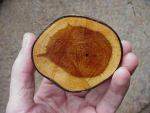
Timber: Yew (Taxus)
Of the timber trees allied to the pine, in their appearance or uses, are the Yew, the Cypress, the Juniper and the Arbor Vitae. These, like the pines, have the common characteristics of being mostly evergreens, and the wood is resinous or bitter.
There are some distinctions - the pine, cypress, juniper and arbor vitae have the male and female flower on the same plant (monoecious). The Juniper and the Yew have the male flowers on one tree and the female flowers on another (dioecious).
The YEW TREE (Taxus, probably from the Greek, signifying 'swiftness' - perhaps an allusion to the speed of an arrow shot from a yew-tree bow) is a tree of some celebrity, in the milirtary and superstitious history of England. The common yew is a native of Europe, North America, and the Japanese Isles.
Caesar mentions it as having been abundant in Gaul, and much of it is found in Ireland, embedded in the earth.
The trunk and branches grow very straight. The bark is cast annually, andthe wood is compact, hard and very elastic. It is therefore of great use in every branch of the arts in which firm and durable timber is required, and before the time of fire-arms, it was in high request for bows. So much of it was needed for this that ships trading to Venice were required to bring ten bow staves along with every butt of Malmsey.
The yew was also consecrated - a large tree, or more, being in every churchyard, and they were held sacred. In funeral processions the branches were carried over the dead by mourners, and put under the coffin in the grave.
The following extract from the ancient laws of Wales will show how valuable was this tree, and how its value had risen above that of the reputed sacred mistletoe of the Druids:
"A consecrated yew, its value is a pound.
"A mistletoe branch, threescore pence.
"An oak, sixscore pence.
"Principal branch of an oak, thirty pence.
"A yew-tree (not consecrated) fifteen pence.
"A sweet apple, threescore pence.
"A sour apple, thirty pence.
"A thorn-tree, seven pence halfpenny. Every tree after that, fourpence.
By a statute in the 5th year of Edward IV's reign, every Englishman and Irishman dwelling with Englishmen was directed to have a bow of his own height made of yew, wych-hazel, ash or laburnum. His skill in the use of the long bow was the distinction of the English yeoman, and it was his boast that none but an Englishman could bend that powerful weapon.
There are less yew trees now than previously. Considering the yew; its great strength, durability and even beauty of the timber; one cannot help regretting that in consequence of the great improvement of iron manufacture, many of the uses to which yew was put are now met by iron.

summarised from "The Library of Entertaining Knowledge - Timber trees" (1829), pub. Charles Knight, Pall Mall.
ND, habitat21
big turbines
small turbines